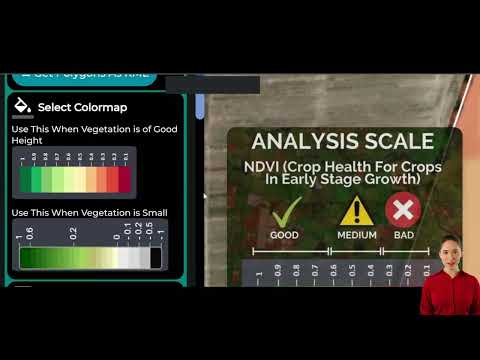Breaking News: Ontario Crop Insurance Dispute Resolved After Decade-Long Appeal Process
“A decade-long crop insurance dispute in Ontario highlights the importance of timely documentation, affecting thousands of farmers annually.”
In a landmark decision that has sent ripples through the agricultural community, a long-standing crop insurance dispute in Ontario has finally reached its resolution after a grueling decade-long appeal process. This case has not only captured the attention of farmers across Canada but has also shed light on the critical importance of agricultural dispute resolution and the evolving landscape of farm technology solutions.

As we delve into the intricacies of this compelling case study, we’ll explore the challenges faced by farmers navigating the complex world of crop insurance claims, the role of advanced agricultural technologies in dispute resolution, and the lessons learned from this protracted legal battle. Our analysis will provide valuable insights for farmers, industry professionals, and policymakers alike, emphasizing the need for robust documentation, active engagement in legal proceedings, and the adoption of cutting-edge farm management tools.
The Genesis of the Dispute
The dispute in question originated in rural Ontario, where a group of farmers found themselves at odds with their crop insurance provider over claims related to significant crop damage. The initial incident that sparked the controversy occurred during a particularly harsh growing season, characterized by extreme weather events that devastated large swaths of agricultural land.
At the heart of the dispute lay several contentious issues:
- Disagreements over the extent of crop damage
- Questions regarding the timeliness and accuracy of damage reporting
- Disputes over the interpretation of insurance policy clauses
- Concerns about the methods used for crop damage assessment
These points of contention set the stage for what would become a protracted legal battle, highlighting the complexities inherent in agricultural insurance claims and the need for clear, comprehensive documentation in such cases.
The Appeal Process: A Decade in the Making
The crop insurance appeal process that ensued was unprecedented in its duration and complexity. Over the course of ten years, the case wound its way through various levels of administrative review and legal proceedings, each stage bringing new challenges and revelations.
Key milestones in the appeal process included:
- Initial claim rejections by the insurance provider
- Administrative reviews at the provincial level
- Appeals to specialized agricultural tribunals
- Multiple court hearings, including appearances before higher courts
- Mediation attempts and settlement negotiations
- Final resolution and policy implications
Throughout this lengthy process, the case attracted significant attention from local media, agricultural organizations, and policy experts, all of whom recognized the potential far-reaching implications of the final decision.
The Role of Technology in Modern Agriculture
As the legal proceedings unfolded, the agricultural sector witnessed rapid advancements in technology that would prove pivotal in shaping the outcome of this and future disputes. The evolution of precision agriculture systems, smart farming sensors, and online farm management platforms revolutionized the way farmers could monitor, document, and manage their crops.
These technological advancements play a crucial role in modern farming practices and dispute resolution:
- Satellite-Based Crop Monitoring: Platforms like Farmonaut provide real-time insights into crop health and field conditions, offering valuable data for both farmers and insurance assessors.
- Agricultural Weather Monitoring: Advanced weather tracking systems help farmers anticipate and prepare for adverse conditions, potentially reducing the severity of crop damage.
- Smart Farming Sensors: IoT devices deployed across fields can provide granular data on soil moisture, temperature, and other critical factors, aiding in precise crop management and damage assessment.
- Online Farm Management Systems: Digital platforms streamline record-keeping and documentation, crucial elements in any insurance claim or dispute.
The integration of these technologies into farming practices has not only improved productivity but also enhanced the ability of farmers to provide accurate, timely information in the event of crop damage or insurance claims.
Lessons Learned: The Importance of Documentation and Engagement
One of the key takeaways from this prolonged dispute is the critical importance of thorough, timely documentation in agricultural operations. Farmers who maintained detailed records of their crop management practices, weather conditions, and damage assessments were better positioned to support their claims throughout the appeal process.
“Precision agriculture systems can reduce crop insurance claims by up to 30% through improved risk assessment and damage prevention.”
Essential documentation practices for farmers include:
- Regular field surveys and crop health assessments
- Detailed weather logs and their impact on crop development
- Photographic and video evidence of field conditions and any damage
- Maintenance records for irrigation systems and other farm equipment
- Soil test results and fertilization records
Moreover, the case underscored the importance of active engagement in the legal and administrative processes surrounding insurance claims. Farmers who remained proactive throughout the appeal process, seeking legal counsel when necessary and participating fully in all stages of review, were more likely to achieve favorable outcomes.

The Resolution: Implications for the Agricultural Sector
After a decade of legal wrangling, the Ontario crop insurance dispute finally reached a resolution that has significant implications for the agricultural sector. While the specifics of the settlement remain confidential, the case has prompted a reevaluation of crop insurance policies and claim assessment procedures across Canada.
Key outcomes of the resolution include:
- Enhanced transparency in the crop insurance claim process
- Revised guidelines for crop damage assessment
- Increased emphasis on the use of technology in monitoring and documenting crop conditions
- Improved appeal mechanisms for disputed claims
- Greater recognition of the challenges faced by farmers in documenting extensive crop damage
These changes are expected to benefit farmers by providing clearer pathways for claim resolution and encouraging the adoption of advanced farm management technologies.
The Future of Agricultural Dispute Resolution
As we look to the future, it’s clear that the landscape of agricultural dispute resolution is evolving rapidly. The integration of technology into farming practices is not only improving productivity but also changing the way disputes are handled and resolved.
Key trends shaping the future of agricultural dispute resolution include:
- Data-Driven Decision Making: The increasing availability of precise, real-time data from sources like satellite imagery and IoT sensors will provide more objective evidence in dispute cases.
- AI and Machine Learning: Advanced algorithms will help in analyzing complex datasets, potentially identifying patterns and insights that could be crucial in resolving disputes.
- Blockchain Technology: The use of blockchain for creating immutable records of crop conditions and management practices could revolutionize the way evidence is presented and verified in insurance claims.
- Remote Sensing: Improved satellite and drone technology will enhance the ability to assess crop damage accurately and efficiently, even in remote or inaccessible areas.
- Digital Platforms for Dispute Resolution: Online platforms may streamline the dispute resolution process, making it more accessible and efficient for all parties involved.
These technological advancements are poised to transform the agricultural sector, making dispute resolution more efficient, transparent, and fair for all stakeholders.
Embracing Technology: A Path Forward for Farmers
In light of the lessons learned from the Ontario crop insurance dispute and the ongoing technological revolution in agriculture, it’s clear that embracing modern farm management tools is crucial for farmers looking to protect their interests and optimize their operations.
Platforms like Farmonaut offer comprehensive solutions for satellite-based crop monitoring, providing farmers with valuable insights into their field conditions and crop health. By leveraging such technologies, farmers can:
- Monitor crop health in real-time
- Detect potential issues before they escalate
- Maintain detailed records for insurance and regulatory purposes
- Optimize resource usage and improve overall farm productivity
Explore Farmonaut’s offerings:
For developers and businesses looking to integrate advanced agricultural data into their own systems, Farmonaut also offers API access:
Conclusion: A New Era for Agricultural Risk Management
The resolution of the Ontario crop insurance dispute marks a significant milestone in the evolution of agricultural risk management and dispute resolution. As we move forward, the integration of advanced technologies, improved documentation practices, and more transparent insurance processes will be crucial in protecting farmers’ interests and ensuring the stability of the agricultural sector.
By staying informed about industry trends, adopting modern farm management tools, and maintaining meticulous records, farmers can better navigate the complexities of crop insurance and dispute resolution. The lessons learned from this decade-long case serve as a powerful reminder of the importance of proactive risk management and the potential of technology to transform agricultural practices.
As we embrace this new era of precision agriculture and data-driven decision-making, the future looks bright for farmers who are willing to adapt and leverage the power of modern farm technology solutions.
Timeline of Ontario Crop Insurance Dispute Resolution
| Year | Significant Events | Legal/Administrative Actions | Technological Advancements |
|---|---|---|---|
| 2010 | Severe weather events cause widespread crop damage | Initial insurance claims filed | Introduction of basic satellite imagery for agriculture |
| 2012 | Farmers receive claim rejections | First round of appeals initiated | Emergence of early smart farming sensors |
| 2014 | Media attention grows as dispute continues | Case reaches provincial agricultural tribunal | Development of more sophisticated crop monitoring systems |
| 2016 | Farmer advocacy groups become involved | First court hearings take place | Widespread adoption of precision agriculture techniques |
| 2018 | New evidence emerges from technological sources | Case moves to higher court | AI and machine learning begin to impact agricultural data analysis |
| 2020 | Renewed negotiations between parties | Mediation attempts and settlement discussions | Integration of blockchain in agricultural supply chains |
| 2022 | Final resolution reached | Implementation of new policies and procedures | Advanced satellite-based crop monitoring becomes standard |
FAQ: Ontario Crop Insurance Dispute Resolution
Q: What was the main cause of the Ontario crop insurance dispute?
A: The dispute originated from disagreements over crop damage assessments, claim rejections, and interpretation of insurance policy clauses following severe weather events that caused widespread crop damage.
Q: How long did the appeal process take?
A: The appeal process lasted for a decade, involving multiple stages of administrative review and legal proceedings.
Q: What role did technology play in resolving the dispute?
A: Advancements in precision agriculture, satellite-based crop monitoring, and smart farming sensors provided more accurate data for crop damage assessment and documentation, influencing the resolution process.
Q: What are the key lessons for farmers from this case?
A: The case highlights the importance of thorough documentation, timely reporting of crop damage, active engagement in the legal process, and adoption of modern farm management technologies.
Q: How might this case impact future crop insurance policies?
A: The resolution is likely to lead to more transparent claim processes, revised damage assessment guidelines, and increased emphasis on technology use in monitoring and documenting crop conditions.
Q: What steps can farmers take to better protect themselves in insurance disputes?
A: Farmers should maintain detailed records, utilize advanced farm management tools, stay informed about their insurance policies, and seek prompt legal advice when disputes arise.
Farmonaut Subscriptions
In conclusion, the resolution of the Ontario crop insurance dispute after a decade-long appeal process marks a significant milestone in agricultural risk management. This case underscores the critical importance of embracing technology, maintaining meticulous documentation, and actively engaging in the legal process. As we move forward, farmers who leverage advanced farm management tools and stay informed about industry trends will be better equipped to navigate the complexities of crop insurance and dispute resolution. The agricultural sector is entering a new era of precision and data-driven decision-making, promising a more secure and prosperous future for farmers willing to adapt and innovate.






